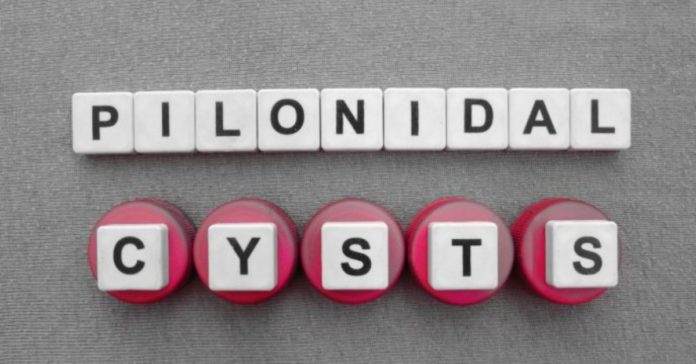pilonidal cysts is a fluid-filled sac of tissue located at the base of the spine, near the crease of your buttocks. It presents as a small pit or dimple in the skin area overlying the tailbone or the coccyx. Pilonidal cyst can be very painful, especially while sitting.
Pilonidal cysts usually occur as a result of a skin infection. They typically start when hair follicles puncture the skin and become embedded and infected. It can be either an acute (one-time problem) or a chronic (recurring) issue. It usually occurs more often in younger people, especially males. During World War II, it was referred to as “Jeep Driver’s disease”, as it is more prevalent in people required to sit for prolonged periods.
Signs and Symptoms of Pilonidal Cysts
Some symptoms of pilonidal cysts are:
- The presence of pain in the area above the tailbone, which aggravates further while sitting
- The presence of small dimples or large swelling in the area between your buttocks indicates pilonidal cysts. The affected area is usually red and tender to the touch.
- A foul-smelling odour or pus draining from the affected area might be observed.
- Developing a fever is possible.
Risk Factors for Pilonidal Cysts
The following are some risk factors:
- Males are more commonly affected than females
- People living a sedentary lifestyle are at risk
- People with thick body hair are at risk
- Overweight or obese people face higher risks
- A family history of pilonidal cysts may increase an individual’s risks
- Poor hygiene may result in cysts
When to See a Doctor
If you have any symptoms of pilonidal cysts from those listed above, you should see a doctor.
Call 1860-500-1066 to book an appointment
Diagnosis
Your doctor will ask you about your symptoms, note your medical history, and perform a full physical examination. The area in the crease of your buttocks will be examined for signs of a pilonidal cyst. The doctor may order a CT scan or an MRI for further examination if required.
Treatment of Pilonidal Cysts
- Incision and Drainage: This procedure involves making a tiny incision and draining the fluid from the infected cyst.
- Antibiotics: While antibiotics alone cannot heal pilonidal cysts, they are used to treat the infection.
- Laser therapy: It is used to remove hair follicles that may become ingrown and cause pilonidal cysts to recur
- Surgical options: If chronic pilonidal cysts are present, which have caused the formation of a sinus cavity under the skin, surgery is essential to remove the cyst entirely.
Post-surgery precautions include:
- Keeping the area clean.
- Checking for signs of a new infection; these signs include redness, pus, or pain.
- Following up with your doctor so that they can monitor the healing progress.
Prevention Measures
The following measures may impede the growth of pilonidal cysts and prevent them from appearing on your body.
- Keep the area clean
- Lose weight if you are obese/overweight
- Avoid sitting for prolonged periods. Take breaks frequently if you have to sit for long periods
- Do not wear tight clothes as they can push the hair down into your skin
If you had pilonidal cysts in the past, shave the area or use hair removal products to reduce the risk of recurrence.
Home Remedies
You may try these home remedies for relief.
- Soak in a tub of warm water as this will help relieve the pain
- Keep the area around the cyst clean and dry
Prognosis
While these cysts are not serious, they may get infected further if left untreated. This can cause formation of an abscess, and eventually, lead to pus draining through a sinus cavity.
The pilonidal cyst prognosis is generally good. Often, it is treated using surgical methods. However, the chances of an abscess recurrence are quite high if there is a formation of extensive scar tissue or a sinus tract. Even with surgical methods, a small number of cysts always tend to recur.
Frequently Asked Questions (FAQs)
What is the duration of a pilonidal cyst?
A pilonidal cyst may remain until incision and drainage or surgery is performed by doctors, after which it usually takes one to two months for the wound to heal. The recovery period may extend to six months at times.
Is a pilonidal cyst contagious?
A pilonidal cyst is non-contagious and does not spread from one person to another.
Is a pilonidal cyst hereditary?
In certain cases, a pilonidal cyst can be hereditary. For example, if rough body hair growth runs in your family, they can cause these cysts.
What makes a pilonidal cyst worse?
When a pilonidal abscess becomes infected, it will cause swelling and make it very difficult to sit, stand, or lie down, and any movement will aggravate the pain further.
What kind of doctor removes a pilonidal cyst?
Pilonidal cysts are removed by a procedure called pilonidal cystectomy. It is a minor surgical procedure performed by a colorectal surgeon.


















